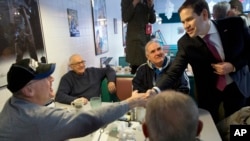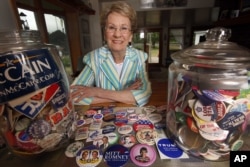The New Hampshire primary taking place Tuesday traditionally is the first such event in the U.S. presidential election cycle occurring every four years. It typically follows the Iowa caucuses, this year staged February 1.
Those are the first contests in the U.S. presidential election cycle, which has two voting phases.
First, in a series of caucuses and primaries staggered through mid-June, voters in each state and territory choose delegates who’ll eventually select a nominee for each major party. Then, the Republican and Democratic nominees – and sometimes others – will top the ballots for a nationwide Election Day on the first Tuesday after the first Monday in November. This year, it falls on November 8.
Here's a look at the first voting phase.
What is the difference between a primary and a caucus?
The primary elections are run by state and local governments, while caucuses are private events that are directly run by the political parties themselves. Some states only hold caucuses, and others use a combination of both. Voting takes place on different days in different states.
State governments fund and run primary elections in much the same way they do the general election in the fall. Voters go to a polling place, vote and leave.
At a caucus, individuals viewed favorably within the party are identified as potential delegates. After a comprehensive discussion and debate, an informal vote is held to determine which individuals will serve as delegates at the national party convention.
What are the types of primary elections and caucuses?
The four most common types of primary elections are open, closed, semi-open and semi-closed. Each state must decide which type it wants to adopt.
Open primaries and caucuses allow all registered voters, regardless of party affiliation, to vote in any party contest. Certain states using this format may print a single ballot, on which the voter chooses which political party's candidates they will select for a contested office.
Closed primaries and caucuses require voters to register with a specific party to be able to vote for that party’s candidates.
Semi-open primaries and caucuses allow any registered voters to vote in any party contest. But, when they identify themselves to election officials, they must request a party’s specific ballot.
Semi-closed primaries and caucuses follow the same rules as closed ones, but they also allow voters who are not affiliated with a political party to vote.
How does the New Hampshire primary work?
The northeastern state has been a proving ground for candidates for decades.
Candidates practice so-called "retail politics," meeting face to face with prospective voters in informal settings – such as diners, at church suppers and in school gyms – as well as at formal debates. Because this contest has gained national prominence for its ability to reshape candidates' fortunes, news media representatives and political tourists come from all over, sometimes outnumbering New Hampshire voters at events.
New Hampshire’s primary is semi-open, enabling voters who haven’t registered with a party to still have a voice in the outcome. But they can’t vote for another party. Voters cast anonymous ballots at regular polling places.
The Granite State's primary is peculiar in that different communities can set different voting hours. Most polls statewide are open from 7 a.m. to 7 p.m. But, as NPR notes, three few tiny towns – Dixville Notch, Hart’s Location and Millsfield – open their polls to voters just after midnight.
New Hampshire's primary also is wide open to anyone who wants to run for the top office and is willing to pay a $1,000 filing fee or gather at least 100 signatures showing support. That has given rise to fringe candidates such as "Lobsterman," New Hampshire historian Michael Chaney explains in a C-SPAN video lesson on the primary.
What are a few facts about New Hampshire voters?
More than half a million voters are expected to take part in this year’s primary, say experts at the University of New Hampshire's Carsey School of Public Policy. They note that, in part because of demographic changes, "the Democratic primary voter base has grown significantly, but the Republican base has not."
The state’s 1.3 million residents are almost all white (94 percent), and largely rural. Among the nation’s 330 million residents overall, 63 percent identify as non-Hispanic whites and just 15 percent live in rural counties, census data show.
.










